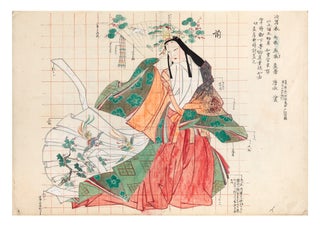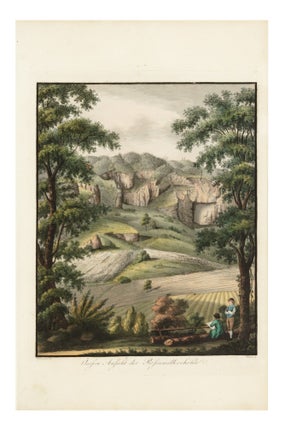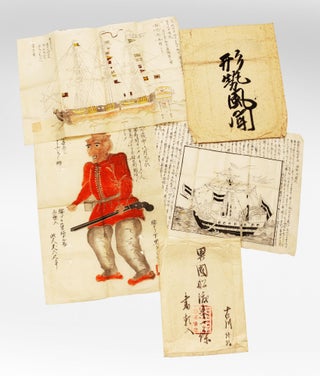Handscroll on paper, entitled (partially defective), at beginning of scroll on outside, “Ninnō kyōhō Hyakkan no uchi Daigoji” [“Doctrine of the Sutra for Humane Kings, a part of 100 sections, Daigoji Temple”], and on adjacent pasted cont. label “Ninnō hō,” apparently a later version of the first part (or scroll) of Ninnō kyōhō [Doctrine of the Sutra for Humane Kings].
15 brush & black ink drawings pasted-in and 11 brush & ink drawings directly painted on the scroll (see below). With text on inside & outside of scroll. Siddham script used in the scroll. Scroll (330 x 12,130 mm.), wooden core roller. [Japan]: from recto of scroll at end: “Tenth day of the eighth month of the fourth year of Karyaku [1329].”
This handscroll is part of a larger Japanese work of Buddhist scrolls known as Kakuzenshō [Collected Notes of Kakuzen], one of the two major collections of ritual texts from the period (see Richard Bowing, The Religious Traditions of Japan 500-1600, Cambridge U.P.: 2008, p. 342). The compiler was the early Kamakura-period Shingon monk Kakuzen 覚禅 (b. 1143-ca. 1213), a cleric of the Ono branch, who studied under several great masters including Kozen (1121-1203). Kakuzen produced this work between 1176 and 1213. If our conjecture is correct (see below), this copy was made in 1329. Rather than a copy of the first scroll of Doctrine of the Sutra for Humane Kings, it should be considered a later version of it, as the content differs from the early versions.
Kakuzen belonged to the Shingon (“True Word” or mantra) school of esoteric Buddhism. The texts fundamental to the school were translated in China, but it was in Japan that Shingon became established as an independent sect. Esoteric Buddhism, including Shingon, flourished in medieval Japan and remained influential thereafter. One of the characteristics of the Shingon sect is its focus on ritual, which is also seen in Doctrine of the Sutra for Humane Kings.
The Sutra for Humane Kings, the doctrine of which the scroll is said to present, is a so-called apocryphal scripture, in that it was written in China and not translated from a Sanskrit original (although Siddham is used). The sutra is directed toward the monarch and seeks to promote a Buddhist state. It should be noted that the word translated as “humane” (here Ch.: ren, J.: jin or nin) is a core virtue in Confucianism, East Asia’s foremost doctrine of statecraft.
The beginning of the scroll contains a list of “foundational texts” (honsho 本書). These include, among other things, the Sutra for Humane Kings itself, a ritual commentary on that work, and chants. A lengthy section at the beginning of the scroll is titled “mandala of the five regions.” The term mandala can refer to altars onto which buddhas or bodhisattvas are placed, or groups of such altars, as well as magic circles or squares in whose subdivisions divinities and symbols are depicted. In the scroll, this section contains depictions of several deities. The accompanying text describes them.
The first set of pictures is grouped under the eastern region, one of five regions. At the top, we have Vajrapāṇi 金剛手, a protective deity. He is accompanied by what we think are gandharva 乾達婆, creatures that exist in between birth and death and survive on perfume vapors. To Vajrapāṇi’s left is Samantabhadra Bodhisattva 普賢[菩薩], who symbolizes the teaching, meditation, and practice of the Buddha. Beneath this bodhisattva is Trailokya-vijaya 降三世, “conqueror of the three worlds,” described in the accompanying legend as having three faces, eight arms, and a blue-black complexion. The next sets of illustrations represent the southern region, followed by the western, northern, and central regions. In some of the pasted-in images, several figures are depicted.
The illustrations that follow indicate the outfitting of the ritual space, with accompanying descriptions from (the two versions of) the Sutra for Humane Kings and Japanese Shingon precedent. There is also one more figure that we have been unable to identify.
The copious text on the verso of the scroll is contemporary commentary.
Many dates are mentioned in the text. As far as we can tell, none is later than that of the colophon at the end of the recto side of the scroll. We learn that this text was passed down by word-of-mouth and then written down for a select audience. Kakuzen’s name and age (47) are present in the year 1189. We believe that the date ought to be “Tenth day of the eight month of the fourth year of Karyaku 嘉曆,” which would correspond to 1329. The cursive script might allow for another reading than Karyaku, and what we interpret as “fourth year” is written using what looks like a reduplicated Chinese character for “two,” which we interpret to mean “four” (it also looks like the Change Classic hexagram “great yin,” but to our knowledge that is not used to indicate dates).
We have compared this scroll to the critical edition typeset in Dai Nihon Bukkyō zensho 大日本佛教全書 [Complete Buddhist Corpus of Japan], where the corresponding part is the first of two scrolls that make up what is there titled simply Ninnō kyō [Sutra for Humane Kings]. The texts are similar enough to conclude that it is the same work, but there are differences both in the text, in the images included, and in the appearance of images common to both this scroll and the typeset version. We have not been able to find out which manuscripts the Dai Nihon Bukkyō zensho is based on.
PROVENANCE: At the beginning of the scroll on the outside, there is a contemporary note (in trans.): “Head of Shobo’in,” a part of an unknown temple compound. On the 20th-century wrapper on the outside of the box, there is a note stating: “Chita gun. Senkoji kyokan” [“Chita area, the sutra scroll of Senkoji, the temple in Hiroshima”]. The note continues (in trans.): “10 August 1329 at Hiroshima, Chita area, Senkoji Temple, copied by Koson.”
Minor staining. There is some repeated worming, occasionally touching images, but we do not find it offensive.
❧ Dai Nihon Bukkyō zensho (Tokyo: Bussho Kankokai, 1913), Vol. 46, Part 2.
Price: $17,500.00
Item ID: 9134

![Item ID: 9134 Handscroll on paper, entitled (partially defective), at beginning of scroll on outside, “Ninnō kyōhō Hyakkan no uchi Daigoji” [“Doctrine of the Sutra for Humane Kings, a part of 100 sections, Daigoji Temple”], and on adjacent pasted cont. label “Ninnō hō,” apparently a later version of the first part (or scroll) of Ninnō kyōhō [Doctrine of the Sutra for Humane Kings]. KAKUZEN 覚禅.](https://jonathanahill.cdn.bibliopolis.com/pictures/9134.jpg?width=768&height=1000&fit=bounds&auto=webp&v=1684233092)
![Handscroll on paper, entitled (partially defective), at beginning of scroll on outside, “Ninnō kyōhō Hyakkan no uchi Daigoji” [“Doctrine of the Sutra for Humane Kings, a part of 100 sections, Daigoji Temple”], and on adjacent pasted cont. label “Ninnō hō,” apparently a later version of the first part (or scroll) of Ninnō kyōhō [Doctrine of the Sutra for Humane Kings].](https://jonathanahill.cdn.bibliopolis.com/pictures/9134_2.jpg?width=320&height=427&fit=bounds&auto=webp&v=1684233092)
![Handscroll on paper, entitled (partially defective), at beginning of scroll on outside, “Ninnō kyōhō Hyakkan no uchi Daigoji” [“Doctrine of the Sutra for Humane Kings, a part of 100 sections, Daigoji Temple”], and on adjacent pasted cont. label “Ninnō hō,” apparently a later version of the first part (or scroll) of Ninnō kyōhō [Doctrine of the Sutra for Humane Kings].](https://jonathanahill.cdn.bibliopolis.com/pictures/9134_3.jpg?width=320&height=427&fit=bounds&auto=webp&v=1684233092)
![Handscroll on paper, entitled (partially defective), at beginning of scroll on outside, “Ninnō kyōhō Hyakkan no uchi Daigoji” [“Doctrine of the Sutra for Humane Kings, a part of 100 sections, Daigoji Temple”], and on adjacent pasted cont. label “Ninnō hō,” apparently a later version of the first part (or scroll) of Ninnō kyōhō [Doctrine of the Sutra for Humane Kings].](https://jonathanahill.cdn.bibliopolis.com/pictures/9134_4.jpg?width=320&height=427&fit=bounds&auto=webp&v=1684233092)
![Handscroll on paper, entitled (partially defective), at beginning of scroll on outside, “Ninnō kyōhō Hyakkan no uchi Daigoji” [“Doctrine of the Sutra for Humane Kings, a part of 100 sections, Daigoji Temple”], and on adjacent pasted cont. label “Ninnō hō,” apparently a later version of the first part (or scroll) of Ninnō kyōhō [Doctrine of the Sutra for Humane Kings].](https://jonathanahill.cdn.bibliopolis.com/pictures/9134_5.jpg?width=320&height=427&fit=bounds&auto=webp&v=1684233092)
![Handscroll on paper, entitled (partially defective), at beginning of scroll on outside, “Ninnō kyōhō Hyakkan no uchi Daigoji” [“Doctrine of the Sutra for Humane Kings, a part of 100 sections, Daigoji Temple”], and on adjacent pasted cont. label “Ninnō hō,” apparently a later version of the first part (or scroll) of Ninnō kyōhō [Doctrine of the Sutra for Humane Kings].](https://jonathanahill.cdn.bibliopolis.com/pictures/9134_6.jpg?width=320&height=427&fit=bounds&auto=webp&v=1684233092)
![Handscroll on paper, entitled (partially defective), at beginning of scroll on outside, “Ninnō kyōhō Hyakkan no uchi Daigoji” [“Doctrine of the Sutra for Humane Kings, a part of 100 sections, Daigoji Temple”], and on adjacent pasted cont. label “Ninnō hō,” apparently a later version of the first part (or scroll) of Ninnō kyōhō [Doctrine of the Sutra for Humane Kings].](https://jonathanahill.cdn.bibliopolis.com/pictures/9134_7.jpg?width=320&height=427&fit=bounds&auto=webp&v=1684233092)
![Handscroll on paper, entitled (partially defective), at beginning of scroll on outside, “Ninnō kyōhō Hyakkan no uchi Daigoji” [“Doctrine of the Sutra for Humane Kings, a part of 100 sections, Daigoji Temple”], and on adjacent pasted cont. label “Ninnō hō,” apparently a later version of the first part (or scroll) of Ninnō kyōhō [Doctrine of the Sutra for Humane Kings].](https://jonathanahill.cdn.bibliopolis.com/pictures/9134_8.jpg?width=320&height=427&fit=bounds&auto=webp&v=1684233092)
![Handscroll on paper, entitled (partially defective), at beginning of scroll on outside, “Ninnō kyōhō Hyakkan no uchi Daigoji” [“Doctrine of the Sutra for Humane Kings, a part of 100 sections, Daigoji Temple”], and on adjacent pasted cont. label “Ninnō hō,” apparently a later version of the first part (or scroll) of Ninnō kyōhō [Doctrine of the Sutra for Humane Kings].](https://jonathanahill.cdn.bibliopolis.com/pictures/9134_9.jpg?width=320&height=427&fit=bounds&auto=webp&v=1686229935)



